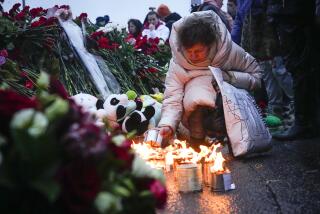COLUMN ONE : Moscow’s Tunnel of Death : An alarming number of people are stepping in front of subway trains. Social tensions in a changing Russia are blamed, but some also see in a famous literary heroine a macabre inspiration.
- Share via
MOSCOW — Crowded escalators plunge swiftly into the dim depths of the Metro, hurling their loads of humanity onto the heels of commuters milling on the platforms below. A grimy train screeches into the station behind an acrid blast of wind. The impatient people push and shove. The inattentive get trampled. The steel doors of the cars slam shut in seconds, abandoning the slow and the weak and the elderly to wage their battles for passage another time.
The subway in this mean city of 10 million is a place that reminds the downtrodden of the social order. The indifference of fellow passengers to the individual dramas and crises swirling around them reinforces fears of the depressed and lonely that life would go on just as well without them, experts say.
And it is at rush hour, in this most frenzied and unfriendly of public places, that an alarming number of Muscovites choose to end their lives by throwing themselves before trains in a macabre imitation of the tragic heroine of Leo Tolstoy’s “Anna Karenina.”
More than 200 suicides have been committed or attempted on the tracks of the Moscow Metro in the past five years, according to Natalia Y. Mironova, a statistician with the system, which handles nearly 9 million rides a day.
Why the busiest mode of transport has become the venue for such acts of desperation is explained by psychiatrists and sociologists as a combination of heightened social tensions and convenience.
Like Tolstoy’s fictional noblewoman, the despondent may be lulled to destruction by the mesmerizing notion that escape and oblivion await them on the rails.
The gory conclusion to “Anna Karenina,” written between 1873 and 1876, was itself inspired by a suicide at a train station a few miles from the author’s home in the rural repose of Yasnaya Polyana in 1873, according to his biographers.
An allegory of the moral and spiritual decadence that followed Europe’s industrial revolution, Tolstoy’s epic novel depicts a despondent heroine immersed in the self-pitying introspection that is seemingly more prevalent now than during the czarist era in which the story is set.
“Yes, I am very troubled, and reason was given man that he might escape his troubles,” Anna muses after her romance withers with Count Vronsky, for whom she has abandoned her husband and son. “Therefore I must escape. Why not put out the candle when there’s nothing more to see, when everything looks so revolting?”
The forbidding atmosphere of modern Moscow stirs similar sentiments.
“The Metro is a very unpleasant place, especially for those who are under stress,” Alexander P. Muzychenko, deputy director of Moscow’s Psychiatry Research Institute, observes of the morbid phenomenon that has become common practice. “It’s dark and crowded and brutal. It is just the environment for intensifying alienation and brooding.”
Suicide on the Rise
Suicide is on the rise in troubled Russia, which now has the third-highest rate after Hungary and Finland. In the first six months of 1995, 62,000 suicides were recorded across Russia--already matching the figure for all of 1994.
Moscow police last year recorded 56 cases of people throwing themselves in the path of Metro trains. The 30 incidents in the first six months of this year suggest even that record will be exceeded. In the last week of August alone, there were four suicide attempts reported to police by Metro drivers.
Nineteen of the incidents last year were immediately fatal, but authorities have no figures on the overall proportion of deadly cases because no one follows up on those taken from the tracks alive.
Suicides in the Metro are believed to be even more frequent than official statistics suggest because dozens of deaths on the subway rails each year are classified as accidents for lack of witnesses who can say whether the victims jumped or fell. Failed attempts in which the trains are stopped in time are seldom reported to police because Metro workers seek to avoid the delay and bother of investigations.
Alexander Sharipov, a 30-year-old locomotive driver involved in a fatal incident in July, says it was the second suicide committed in his path this year. The other one occurred in February. He was able to stop in time to avoid hitting a third jumper one June evening.
“It’s a terrible shock when it happens,” Sharipov says. “You can see what the guy is going to do, but you can’t do anything about it. There were no medics at the Ilyich Square station [where the July incident occurred], so I had to get down on the rails myself to remove the body.”
Suicides and self-inflicted injuries have soared in recent years because using the Metro is a cheap and easily accessible method, says Muzychenko of the psychiatry institute. He notes that guns and drugs are expensive, rooftops remain off limits even to high-rise residents in highly controlled Moscow and the city has few bridges from which a jump would be fatal.
By comparison, Tokyo, with 11.8 million residents, last year had seven suicide attempts on its equally extensive subway system, six of them fatal. There have been 12 suicides on the Los Angeles Metrolink commuter train system in three years, and four suicides have occurred on two light-rail lines in Southern California since they opened in 1990.
That a particular venue has become associated with suicide is not unique to Moscow. San Francisco’s Golden Gate Bridge has been the scene of more than 1,000 suicidal plunges since its construction in 1937; fatal leaps have also been frequent from Paris’ most famous landmark, the Eiffel Tower.
Subliminal Inspiration
Muzychenko attributes the extraordinary incidence of Metro suicides primarily to the peculiarities of Moscow that make more traditional venues impractical. But he also believes Tolstoy’s heroine may serve as a subliminal inspiration.
“Russian people are very literary,” the psychiatrist says. “Maybe this is something they learned from ‘Anna Karenina.’ ”
The country’s leading researcher into the causes and circumstances of suicides disputes the notion of death imitating art.
“I doubt many of those driven to such extremes are readers of literature,” says Aina G. Ambrumova, who heads the federal Center for Suicide Study. “Most people who jump in front of trains do so spontaneously. They don’t decide they are going to take their lives and then set out for the Metro.”
Deaths in the subway are increasing, Ambrumova says, because the incidence of suicide has risen sharply everywhere in Russia over the past five years amid the disappointments that have followed the heady days of reform and revolution. Ambrumova says suicide statistics were never disclosed during the Communist era, but she has calculated the incidence during czarist times as about three per 100,000 citizens each year.
By 1990, the first full year for which she has figures, 26 of 100,000 Russians took their own lives, Ambrumova says. Last year, the figure was up to 42, she says, adding that an even more dramatic escalation is expected this year. The comparable figure for the United States is 11 per 100,000, Ambrumova says.
“One cause of our enormous growth in suicides is the militant atheism that was practiced in the past,” she says. “We are paying the price for our lack of religion, for being so late to find God.”
Ambrumova’s contention that godless communism is to blame is supported by believers who say that the Russian Orthodox Church is as condemning of suicide as other Christian denominations and that the faithful are rarely among those who take their lives. Suicides rose sharply during the Communist era and continue to increase because more than seven decades of dictatorship were successful in stamping out Russian spirituality, some experts say.
A strengthened role for churches and the charitable institutions they support would help discourage suicides, Ambrumova speculates, but she adds that “a stable economy would help even more.”
Most of those taking their lives in recent years have been young women and penniless pensioners--those who bear the brunt of the hardships inflicted by rising unemployment and inflation, she says.
With fatal plunges from the platforms markedly on the rise, police have stepped up patrols but offer little hope that their higher profile will enhance prevention.
Police have small precincts at each of the city’s 150 Metro stations and patrol around the clock, says Yevgeny V. Arzamastsev of the subway police headquarters.
No Effective Deterrent
The rash of deaths has prompted proposals to install barricades along the open tracks, but Arzamastsev doubts that such a move would be an effective deterrent.
“If a person decides to commit suicide, he’ll do it anyway,” says the police administrator. “If he fails to get onto the Metro rails, he’ll look for a bridge to jump from.”
Mironova, of the Metro statistical office, agrees that subway operators have few means at their disposal to prevent the incidents.
“Barriers are not the answer,” she says. “We had a case recently when a person was prevented from jumping in one station and he killed himself at another station later the same day.”
The Metro official laments the now routine disruptions of service that can delay a million people when the system must be shut down at rush hour.
“We have plenty of other headaches, but these incidents have a morally destabilizing effect,” says Mironova, whose husband, Boris, was at the locomotive controls three years ago when a young man hurled himself into the windshield.
“It still haunts him,” Mironova says, ascribing her husband’s decision to retire from the driving brigade to the deadly incident. “For weeks he kept hearing the sound of the man’s body smashing against the glass.”
Times staff writers Richard C. Paddock in San Francisco and Richard Simon in Los Angeles contributed to this report, as did Chiaki Kitada of The Times’ Tokyo Bureau.
More to Read
Sign up for Essential California
The most important California stories and recommendations in your inbox every morning.
You may occasionally receive promotional content from the Los Angeles Times.











